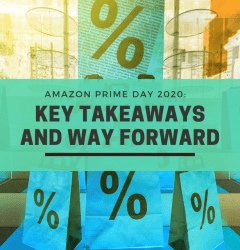This website uses cookies so that we can provide you with the best user experience possible. Cookie information is stored in your browser and performs functions such as recognising you when you return to our website and helping our team to understand which sections of the website you find most interesting and useful.
20 Oct

10 Factors to Consider While Getting Your Offline Business To Online
The previous two COVID-struck years have brought about a sudden transformation in all industries, with even the most legacy offices transitioning gradually to an online mode of operation. The retail domain was no different. So much so that Statista suggests that the eCommerce growth has been up to 300% within the last few years and is expected to make 19.5% of global retail sales by the end of 2022.
It, therefore, comes as no shock that a lot of sellers have today realized the need for supporting their offline businesses with online sales, and capitalizing on the already existing business framework to expand digitally too. By looking at a hybrid model of online + offline sales, you can enjoy the following obvious business benefits:
- Lower operating and starting costs
- Greater coverage and flexibility
- Improved inventory management
- Higher scope of sales
- 24*7 availability
- Enhanced company reputation owing to better customer service
- Increased business visibility and the ability to target global markets.
Clearly, these benefits can make or break a retail business. Now, let’s look at what all you need to know in order to supplement your brick-and-mortar business with a business that resides and operates from the cloud!
Factors to consider when expanding your business into the digital realm:
1. Understanding your business goals and nuances
Not all businesses can thrive in an online model. To truly take your first moves in transitioning your business online, you need to understand your business goals and the nuances that govern it. For instance, Do you service B2C or B2B audiences? Will your existing customers also be online shoppers? Will the transition require a complete overhaul of your current business processes? Answering such fundamental questions will give you a good starting point to establish if it is a right choice to venture into the online working model.
2. Selecting the right CMS
All online businesses, especially those that require secure payments and checkout options, use one or the other CMS to handle their websites. You should select your CMS based on the level of functional requirements and customizations you need. To arrive at the best CMS for your case, the following features must be considered:
- Room for expansion in the CMS
- Availability of systems integration
- Ability to implement the latest tech features
- Multi-language and multi-currency support
- User management and privileges
- Robust backup and recovery systems
- Ability to customize as per your branding and marketing team’s requirements
- Order management and tracking features
- Responsiveness, and much more!
The best way to select the right CMS would be to explore the different options available, try out the different features, and understand which platform is likely to have all the features you are going to need. If you’re just beginning with moving your business online, you can start by using Magento – one of the most used platforms for building online stores. In fact, Gartner’s 2020 Report suggests that Magento has emerged as the leader among various digital commerce platforms available today.
3. Payments and security
Your online retail business will no doubt be accepting online payments. In such a scenario, you need to make it a point to provide the utmost privacy and security to your customers. For that, your website must have PCI-DSS compliant payment solutions to prevent hackers from stealing their personal and credit card information.
Regarding the payment mode, you must choose this keeping the nuances of your business and the general payment preferences of your target audience in mind. So, if you are selling items high in value, or order size in ranges in 10K, 20K USD, then the cost of a credit card will not be viable. Likewise, if you are a B2B business that operates with lower margins, credit card payments again won’t be viable for you.
4. Tax compliances
Every country operates within different tax rules. It is recommended to have a tax professional accessible to help you stay on top of this. Further, while displaying the pricing of your products on your platform, you have to mention the tax information in a way that the local market is accustomed to.
Your website also needs to handle complex tax exemptions, calculations, cross border taxations, different taxes for different countries, and more. This dynamic will change on the basis of the location and type of your business too. For instance, with B2B businesses, tax exemption is a crucial and complicated process. Hence, ensure that you have all the updated information around taxes when it comes to selling your products via an online store.
5. Shipping methods
You will also need to pay close attention to the shipping carriers required to deliver your customers. When choosing a shipping carrier, think about the goods you are going to ship and how much they can weigh, which locations you will be shipping to, the costs involved, and what tracking options will be available. The underlying idea is to present your customers with different shipping options covering both shipping speed and varying price points to provide as many options as possible.
Many times, the CMSs have default modules for integrations with various shipping partners. So, a good idea here is to check if the shipping partner of your choice has ever integrated with the CMS you have selected. Another important thing to keep in mind is that most shipping companies work with some restrictions. Typically, all the companies have a similar list of restricted products. Hence, it is recommended to have a look at these in case you are planning to ship internationally.
6. Order management
Order management includes everything from order routing, printing shipping labels to returns and managing subscriptions. If you already have an order management system in place for your offline business, make sure to integrate it with your online portal. That way, you will not only be able to seamlessly manage your future online orders, but you’ll also have your previous offline orders in one centralized location. The integration will also ensure that your online orders are processed in the same manner as your offline orders – and your ops teams will not have to make any modifications.
In case you already have an ERP system in place, you can use that as well for managing your online orders. This serves two purposes – i) you will be able to track customer orders right from the beginning, and ii) your customers will be able to keep track of their orders.
In the case where you do not have an ERP either, then your CMS should be used for the purpose of order management. However, this requirement should be kept in mind right at the stage when you are selecting the right CMS for your online business and evaluating its capabilities.
7. Allocating specific teams for crucial functions
The moment you shift from offline to online mode of operations, you’ll need to re-evaluate a lot of your business processes. You might need to form specific teams to handle different tasks. The domains that will need specific teams as soon as you shift online include:
- Marketing: The way you market your brand and your products will drastically change when you take the online route. For that, you’ll be better off with having a specific marketing team taking care of your online marketing and promotional strategies.
- Product management: This is a crucial function, even more so for an online store since it requires much more organized cataloging and regular updating than any offline store. To stay on top of essential information such as names, descriptions, SKUs, UPCs, certifications, images, videos and much more – all from a centralized platform. As a result, having a specific team to handle products’ information is highly recommended.
- Inventory: Starting from warehouse and inventory handling, to managing multiple price categories, quantity discounts, and multiple vendors per SKU, to sophisticated inventory reporting – this array of processes needs to be taken care of by an inventory management team for smooth sailing and order processing.
- Order fulfilment: You should also have another specific team for keeping an eye on the different orders received, batch processing, shipping fees, and the efficiency of the order fulfilment process overall.
8. Training the team members on using the new tech stack
The transition from offline to online will impact your team members as much as it will impact your business and its audiences. To keep things seamless and streamlined, you should look for imparting specific training and learnings to different teams handling specific tasks.
9. Choosing the right tech partner
Choosing the right tech partner to support you throughout your offline to online transformation journey is as important as selecting the best tech stack required for meeting your needs. Getting this step will ensure that your ecommerce site keeps growing and flourishing without any roadblocks.
For that, you should look to hire ecommerce partners who match your cultural fit, have worked with businesses like yours, and provide a long-term strategic partnership. They should also be comfortable working on the integrations your ecommerce platforms require and should also bring their tech expertise and provide informed suggestions.
10. Deciding between mobile-first or desktop-first strategies
Nearly 3 out of every 4 dollars spent on online purchases today is done through a mobile device. However, this figure doesn’t mean that you should take the mobile-first route from the get-go. This is a crucial decision to make, and you should focus on the following factors before deciding:
- Who are the target customers? Will they use smaller screens?
- Is your website rich in options, features, and content? If yes, go for a desktop-first approach.
- Are your products going to help other businesses in increasing their productivity? In that case, you can prefer a desktop-first approach.
All in all, the retail world is rapidly evolving, and online shopping is on a steep rise. Today, most retailers are almost compelled to move towards a hybrid (offline + online) selling model to sustain and expand their market share. It completely depends on your decision as to when you want to make this transition.
Industries Served
United States
India













